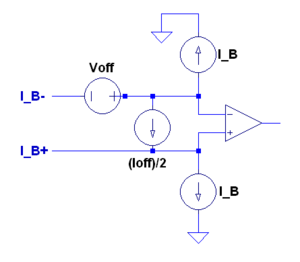Chapter 2: Difference between revisions
Jump to navigation
Jump to search
| Line 94: | Line 94: | ||
*<math>R_{bias}=\frac{R_1R_2}{R_1+R_2}</math> |
*<math>R_{bias}=\frac{R_1R_2}{R_1+R_2}</math> |
||
*<math>R_{bias}\,</math> goes between the positive terminal and <math>V_{in}\,</math> |
*<math>R_{bias}\,</math> goes between the positive terminal and <math>V_{in}\,</math> |
||
*To get rid of unwanted DC components, a capacitor can be added inbetween the positive terminal and <math>V_{in}\,</math>. The bias resistor has the same value, and is placed inbetween the positive input terminal and ground. |
|||
<br> |
<br> |
||
| Line 102: | Line 103: | ||
<br> |
<br> |
||
<br> |
<br> |
||
==Differential Amplifier== |
==Differential Amplifier== |
||
[[Image:Differential_Amplifier_2.PNG|thumb|300px|Differential Amplifier ]] |
[[Image:Differential_Amplifier_2.PNG|thumb|300px|Differential Amplifier ]] |
||
Revision as of 12:34, 12 January 2010
Ideal Op Amp Characteristics
- Infinite input impedance
- Infinite open-loop gain for the differential signal
- Zero gain for the common mode signal
- You can easily change an differential amplifier into a common-mode amplifier by grounding one of the inputs
- Zero output impedance
- Infinite bandwidth
- To allow for infinite gain regardless of the frequency? Instantaneous feedback?
Op Amp Nodal Analysis
- No current flows into the + or - terminals
- If negative feedback is present (and no positive feedback), then
- Write nodal equations at and , but not at
- There is a voltage source inside the op amp. Writing a nodal equation at a voltage source adds an extra equation and an extra variable. You gain no ground.
DC imperfections
- Bias currents, and , are the average dc currents flowing into the op amp input terminals. They can be caused by the signal source, feedback resistors, etc.
- The bias current is the average of the dc currents.
- Offset current is the difference between the bias currents.
- Offset voltage occurs when the output voltage is nonzero for zero input voltage.
Canceling bias currents
- Because bias currents flow have equal magnitude and direction, it is possible to negate their effects.
- The orientation of the offset voltage and the direction of the offset current are unknown, thus it is not possible to correct for these parameters with a circuit design.
Steps
- Ground the input
- Set the output to 0
- Are we doing this so that we can make sure we don't have any other effects, yet the bias will still be there?
- Add in the bias currents
- Add in the new resistor to balance out the bias currents
- Set the two (input terminal) nodal equations equal to each other and solve for the new resistor
Problem 2.17
- Derive an expression for R in terms of the other resistor values, so that the output voltage due to the bias currents is zero.
- Solving the two nodal equations for the terminal voltage and then setting the two equations equal to each other gives:
- Solving for R gives:
Amplifier Circuits
Buffer Amplifier
- Used to transfer voltage but not current to the following circuit. This amplifier can be used to negate the loading effects. No current flows through the amplifier, thus there is no voltage drop through the input resistor (going to the buffer amplifier).
Inverting Amplifier
- Uses negative feedback to invert and amplify voltage. Using nodal analysis at the negative terminal, the gain is found to be
- To get rid of unwanted DC components, a capacitor can be added inbetween and . In this case
Summing Amplifier
- If all resistances are equal, then the output voltage is the (negative) sum of the input voltages
Noninverting Amplifier
- goes between the positive terminal and
- To get rid of unwanted DC components, a capacitor can be added inbetween the positive terminal and . The bias resistor has the same value, and is placed inbetween the positive input terminal and ground.
Differential Amplifier
- If you let and then the equation simplifies to





























